Beyond the “birthday problem”: Qihou Zhou’s new model for a classic probability puzzle
A recent paper by Miami CEC professor Qihou Zhou provides a new model for solving the classic “birthday problem.”

Beyond the “birthday problem”: Qihou Zhou’s new model for a classic probability puzzle
In a recent paper – Birth, Death, Coincidences and Occupancies: Solutions and Applications of Generalized Birthday and Occupancy Problems – Miami University professor of Electrical and Computer Engineering Qihou Zhou explores what is known as the “birthday problem.” The original version of this problem is to find the likelihood of two (or more) people sharing the same birthday in a group, showcasing the unexpected nature of coincidences.
How did Zhou first get started on this problem?
Zhou began his quest for the solution to this problem with a simple question posed to his introductory probability class for engineering students. In the class, he asked: “What is the probability of two people sharing a birthday in this class of 39 students?” He was surprised when several students gave the correct solution almost instantly. (You can try it too: The answer is 87.822%.) Not to be outdone by students so quickly, Zhou raised the stakes and asked: “What is the probability of three people in this class having the same birthday? After a long silence from the class, Zhou conceded that he did not know the exact answer, either.
However, intrigued by the question, Zhou decided to look into this more complex version of the birthday problem after the class. After some calculations, he worked out that the exact solution for three people sharing the same birthday in a group of 39 people is 6.2015% with the leap year considered. Once he had solved this problem, Zhou was hooked – he now wanted to know what it would be like to continue to solve the birthday problem at increasing complexity.
A solution rooted in “elementary logic”
Over the course of a year of rumination and calculation – all occurring amidst the COVID pandemic – Zhou devised a way to solve the birthday problem that works for very general and very diverse situations. Surprisingly, his solution ended up being extremely straightforward. As Zhou wrote in the paper, “the solution process is rooted in elementary logic instead of extensive mathematical derivations.” (To see his solution, please refer to Zhou’s paper, found here.)
Zhou's solution, as it stands today, accommodates uneven birthday distributions and varying numbers of coincidences (or occupancies) thus adding layers of complexity to the original birthday problem. Because of the flexibility of Zhou’s model, it is applicable in a wide variety of real-world scenarios.
Death and other occupancies
As Zhou began expanding the applications of his new model for the birthday problem, he wanted to see how coincidences and occupancies of deaths might fit into his theory. To do this, he initially thought of applying his calculations to measure probabilities related to the occurrence rate of hurricanes and tornadoes. However, Zhou’s work on the birthday problem in 2020-2021 was occurring concurrently with the worldwide COVID pandemic. The concurrence of the pandemic with Zhou’s work led him to alter his examples and instead chart the causes of death to illustrate the application of his model. After all, probabilities related to this theme might be useful to a municipality which sought to assess to what extent its local distribution of causes of death adhered to broader national trends. In this way, Zhou's model provides valuable insights for statistical fluctuation and outlier exclusion strategies.
Zhou’s model also applies to other applications, such as remote workplace flexibility. Imagine a company with one hundred employees, each granted the flexibility to choose a day to work from the comfort of their homes. Surveys show people often favor Wednesdays, closely followed by Mondays and Fridays. With Zhou’s model, workplace planners can predict outcomes, such as the likelihood that 40 or more employees opt to work from home on any given weekday. Since this outcome has the potential to disrupt the efficiency of a 100-employee company, having this data would be highly useful to workplace planners. By harnessing the principles of Zhou’s model, companies can make informed decisions that align with employees' preferences.
Broader implications
In his paper, Qihou Zhou offers a nuanced and adaptable approach to birthday and generalized occupancy problems. The versatility and applicability of Zhou’s solutions pave the way for future exploration in hypothesis testing and probability analysis, with the potential for a deeper understanding of coincidences and occurrences in diverse contexts. For more information and to explore the model in detail, please review Zhou’s paper in full.
Note: This article was composed with assistance from ChatGPT-3.5. It was edited and fact-checked by Katie Rottner, Director of Marketing and Communication for Miami University’s College of Engineering and Computing.